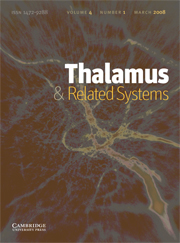Article contents
Centromedian nucleus stimulation for epilepsy Clinical, electroencephalographic, and behavioral observations
Published online by Cambridge University Press: 12 April 2006
Abstract
A series of 49 cases with difficult to control seizures and non-candidates for ablation of the epileptic focus has been treated with electrical stimulation of the centromedian thalamic nuclei (ESCM).
Selected cases were: (1) epilepsia partialis continua (EPC) (n = 5); (2) partial complex seizures (n = 16); (3) bilateral frontal parasagittal seizures (n = 6); (4) Lennox-Gastaut syndrome (n = 22). All patients had four contact electrodes placed bilaterally through frontal parasagittal burr holes and guided by ventriculograms. Plotting of electrodes on sagittal and frontal sections of the Schaltenbrand and Bailey’s atlas permitted to determine their location. Electrodes were left externalized for periods of weeks to months to carry out the following tests. (1) Recordings of spontaneous seizures occurring during wakefulness and sleep. (2) Electrophysiological confirmation of their position by means of recruiting responses and desynchronization induced by low and high frequency stimulation. (3) Effects of high frequency stimulation on interictal and ictal activities. Electrodes were internalized and connected to a subcutaneous pulse generator programmed for alternating right and left ESCM 1 min ON and 4 min OFF at 60–130 Hz, 0.21–0.45 ms, 3–5 V forward and backward for 24 h per day. Repeated EEG recordings and a calendar of seizures were used for follow-up from 1 to 9 years.
CM paroxysmal discharges followed the initiation of seizures in cortical areas, occurred simultaneously with spike wave (SKW) complexes in cortical areas in Lennox-Gastaut syndrome and preceded the initiation of cortical SKW and clinical seizures in typical absences. Low frequency stimulation (6–8 cps) induced recruiting responses that were associated with those electrodes that produced best seizure control. Good to excellent results were obtained in cases of EPC and Lennox-Gastaut syndrome and on generalized tonic clonic convulsions (GTCs) and atypical absences (AA) with tonic or clonic components.
Consequently, we came to the conclusions that the CM participates in the propagation of most seizure types and also in the genesis of some of them and that ESCM is a safe and useful alternative for the treatment of some of the most difficult cases of uncontrollable seizures.
Keywords
- Type
- Research Article
- Information
- Copyright
- 2002 Elsevier Science Ltd
- 10
- Cited by


